
MERCEDES-BENZ’S method of entry into the mid-size four-wheel drive ute market is indicative of the huge growth in this segment. The three-pointed-star brand predicts sales of this type of vehicle will grow up to 50 per cent over the next 10 years, so it wanted in as soon as possible.
To make that happen, Benz partnered with Nissan to adapt the existing D23 Navara to become its new X-Class pick-up. By doing so it cut development time of a new model by half and, after being teased for three years, the X-Class finally landed in Australia in April 2018.
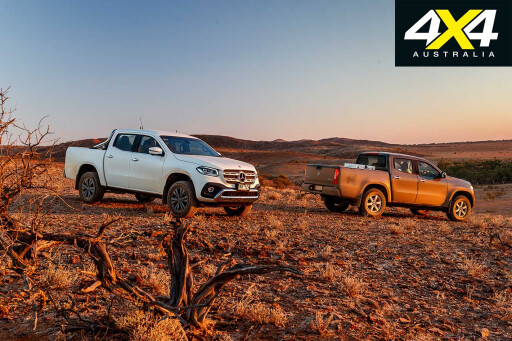 However, don’t think the X-Class is simply a rebadged Navara. It might look similar in a lot of aspects, but it is a very different vehicle. It is wider than the Nissan; the cabin is wider for more interior space, meaning the turret and front and rear screens are also wider. This in turn means the bigger cargo tub is unique to the Benz.
However, don’t think the X-Class is simply a rebadged Navara. It might look similar in a lot of aspects, but it is a very different vehicle. It is wider than the Nissan; the cabin is wider for more interior space, meaning the turret and front and rear screens are also wider. This in turn means the bigger cargo tub is unique to the Benz.
The wheel track is wider, too, thanks to longer suspension arms up front and a wider rear live axle, resulting in a 70mm increase in track. While they were fiddling with the rear-end, the Benz techs also fitted disc brakes in lieu of the drums that are the accepted standard for this class.
The axles are tied to a ladder chassis derived from the Navara’s; although, it has been strengthened for better dynamics. Used in the X-Class is Nissan’s coil-sprung multi-link rear suspension; although, the spring and dampener settings are all Benz in the front and rear.
So Benz did a major makeover of the Nissan and then teased us with it all over the world before finally bringing it to Australia; but there’s only one place we want to test a 4x4 ute, no matter what badge it’s wearing. The Aussie Outback is the ultimate test, with its harsh roads, endless dust, rocky tracks and extreme weather variations. These are the conditions any Australian farmer will drive in every day, and well-heeled farmers are the centre point in Mercedes-Benz’s sights for its new ute, even if we expect most units will be sold in the cities.

With this in mind we locked in two of the new utes – a pair of X250s in mid-spec Progressive and top-spec Power guises – for an outback adventure (the base-spec is called Pure). The X220d and X250d models were launched earlier this year, while the 550Nm V6-powered X-Class won’t arrive until later this year.
HITTIN’ THE ROAD
Each X-Class was loaded with a 60-litre fridge and all the kit needed for a two-week camping trip. Not a heavy load, but indicative of what most recreational four-wheel drivers would carry.
The X-Class utilises the clever adjustable tie-down rails that are also found in the Navara, and these were used to secure the loads. They are mounted high on the sides of the cargo tub, which isn’t always ideal when you are trying to tie something ‘down’ in the tub. Older Nissans also had the rail mounted on the tub floors, which was a better option. The factory fitted, hard-wired 12-Volt power outlet located in the tub was used to power the fridge.

With the rocky roads ahead we wanted to fit some tougher all-terrain tyres, so the X250d Progressive was fitted with a set of Toyo Open Country ATIIs for added durability. The X250d Power rides on 18-inch alloy wheels and suitable tyres weren’t available at such short notice, so we headed off on the standard road-biased rubber with an additional spare.
Day one involved a highway drive from Melbourne to Broken Hill, where the Benzes cruised in comfort and ease. The interior of these utes is a few steps above anything else currently available in this segment, with components taken from the C-Class and V-Class Benzes, including the dash, gauges, seats and trims.
The X250d Power interior is as you’d expect of a Benz. It has heated leather, power-adjustable seats with stitched leather on the dash and door trims, and a black roof lining and trimmed pillars. The Progressive is a bit lower key, with cloth seats, untrimmed dash and pillars, and a light-coloured hood lining.
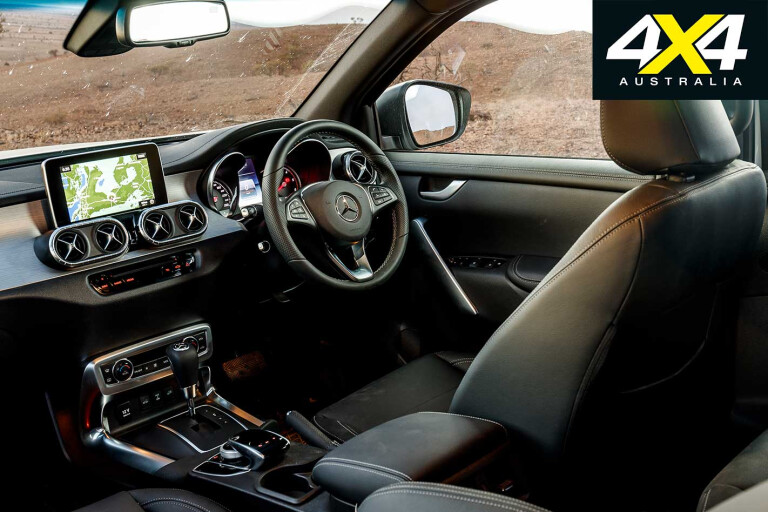
In all X-Class variants the rear seats are raised to improve the view of passengers, and the roof is bulged to accommodate this; however, any passengers more than 180cm tall will find it a tight fit. There were no complaints from those riding up front on long days, though.
One complaint about the cabin is the lack of useable storage space. There is only one coffee-cup holder, and the console bin and glovebox are both small. The door pockets can house large water bottles and map books, while there are three 12-Volt power outlets and two USB ports inside.
Leaving the bitumen behind us at Silverton, we took the back roads north towards Tibooburra, and it wasn’t long before we encountered a problem with the X250d Power. A garden of exposed rocks on a crest in the road was unavoidable, and the X-Class’s tyre pressure monitor almost instantly lit up the dash with a warning.
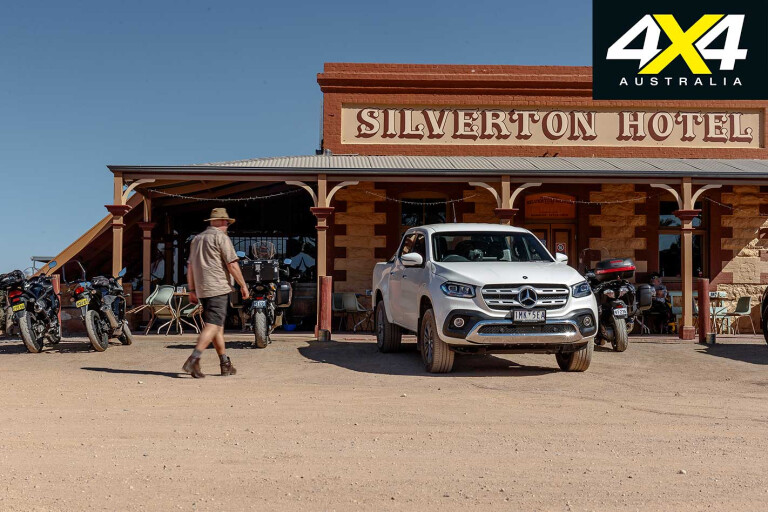
Pulling over revealed a huge cut in the sidewall of the driver’s side rear tyre, and it was duly replaced as we thanked ourselves for that second spare – lucky we did, as the next day we lost another one. This time we were exploring an old mine site, with lots of rocks and sharp stumps scattered around. One of those stumps cut the passenger’s front sidewall, and we felt it before the TPMS had time to warn us.
We crawled along a rocky road to Tibooburra sans spare tyres for the X250d Power, and then hit the phones for replacements. We found a set of General Grabber AT3s that’d serve our purpose, but it meant returning to Broken Hill to have them fitted.
It’s a fitting reminder of how harsh the tracks are out here, and that you shouldn’t be out here on stock road tyres. With the Grabbers on the X250 Power and the Toyo Open Countries on the Progressive, we ventured on without tyre issues for the remainder of the trip.
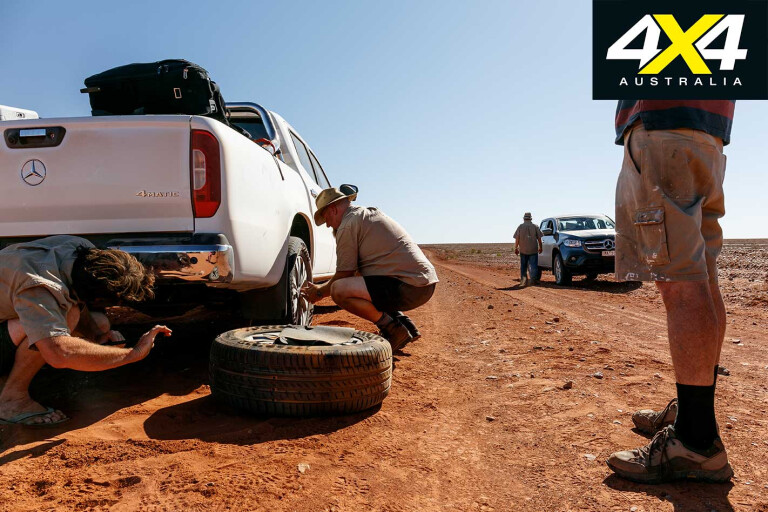
The tracks turned sandy as we passed through Cameron Corner, where the states of New South Wales, South Australia and Queensland meet. The softer, wider tracks allowed a bit more pace, and the stability of the Benzes inspired confidence in these conditions. The added wheel track helps here to spread the weight of the car over a broader footprint, while the calibration of the electronic stability control never interferes unnecessarily on the tracks.
All X-Class models are loaded with safety kit, both passive and active, and this is the first ute in this segment to feature autonomous emergency braking (AEB).

This feature detects any possible forward impact and not only warns the driver of the impending incident but applies the brakes to avoid it if possible, or at least lessen the impact. Other utes have the warning system but not the full AEB at this point; although, we expect other manufacturers to soon follow suit.
The calibration of Benz’s electronic safety systems is very good, but the outback throws up unique conditions (possibly) found nowhere else in the world. One such condition – approaching a cattle grid on a rise which was framed by signs on both sides, on a light sandy-coloured gravel road – tripped up the AEB a couple of times.
The AEB picked up the darker steel grid and signs and suddenly applied the brakes as we hit the grid. After initially applying the brakes, the system must’ve realised there was nothing in front of it and released the brakes, as it didn’t bring the vehicle to a complete stop. This happened three times in the two cars over 5500km of outback roads.
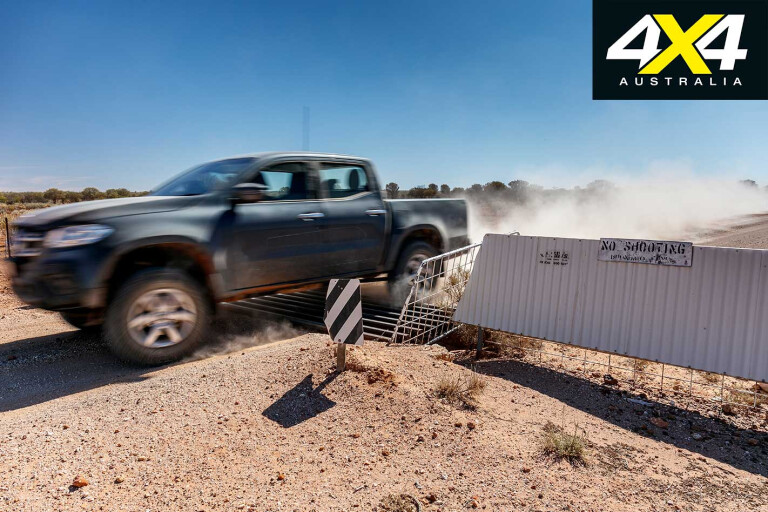
The AEB also activated when avoiding countless kangaroos – another uniquely Australian situation – and even pulled the X-Class up before knocking one over. It slowed the car down and limited the damage, but we felt the ABS calibration could be better for gravel roads – possibly if it had a separate calibration when in 4x4 and on unsealed surfaces.
The four-cylinder X-Class models use a part-time 4x4 system to provide rear-wheel drive, locked 4x4 high range and locked 4x4 low range; standard stuff for a one-tonne ute, as is the inclusion of a rear diff lock. When the V6 X arrives later this year it will have full-time 4x4 including low range, which will be another feature rare in the class – the Mitsubishi Triton being the only other ute with it.
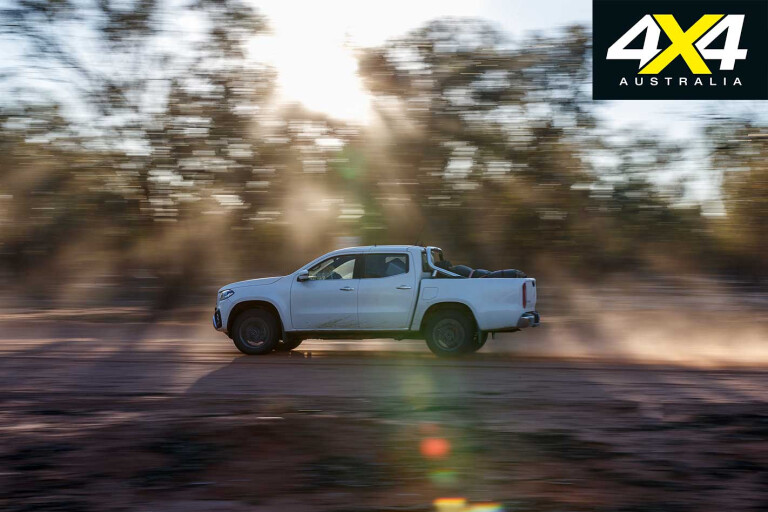
There’s not a lot of need for low range when touring the outback, but slipping into 4x4 high range helps with stability and traction on loose road surfaces. There was the odd occasion for low range when climbing out of a steep, dry river bank or over rocks, and the X wasn’t fazed by these.
Once we crossed into southwest Queensland and broke south toward home, the tracks turned into some of the worst we’d felt on the trip. Surfaces rutted up by previous rains, as well as protruding rocks and corrugations, make for extreme conditions; but throw them all together and it could be vehicle destroying.
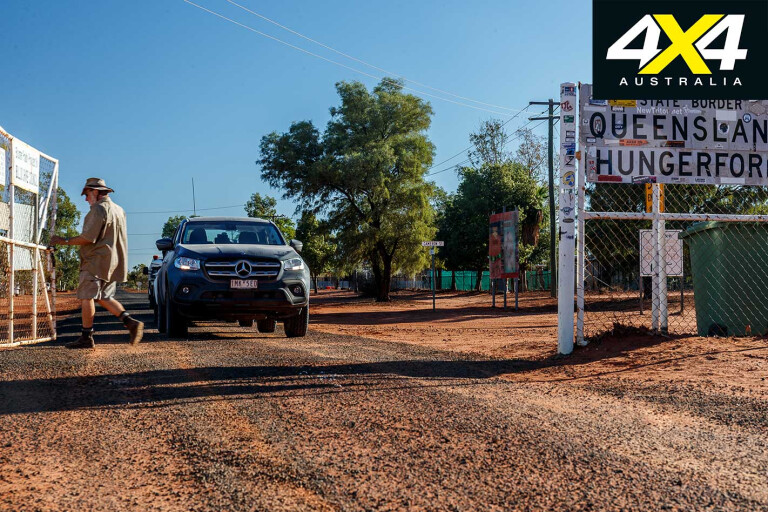
On some of the longer sections of these conditions we felt the shocks start to soften up – the stock units can only take so much torture – but they seemed to come back to life when the roads smoothed out and they cooled.
What was impressive was that, when we hit the bitumen again as we approached Wentworth, neither of the cars had any rattles or squeaks in the cabins, indicating these Benzes are built solid. Those roads, as we headed south, were car-destroying, and we didn’t hold back the speed as we traversed them. Tyres, shocks and every nut and bolt are tested to the limits when pounding these tracks, and both Benzes held up very well.
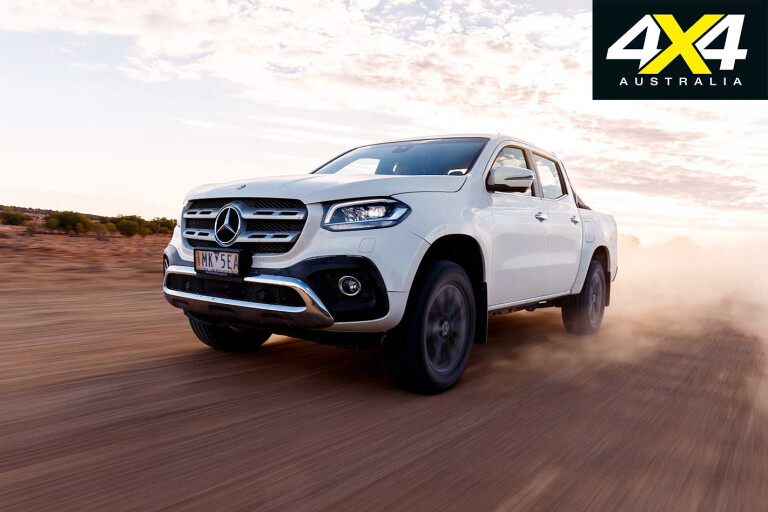
After more than 5500km over two weeks, most of which was on unsealed outback roads, the fuel figures were excellent, with the X250d averaging 9.6L/100km for the trip and the Progressive 9.8L/100km. Bear in mind both cars were on non-OE all-terrain tyres and that the ones fitted to the Progressive were slightly taller than OE spec.
The big question remains: Is the X-Class worth the price premium over its competitors? The Progressive and Power retail for $62,990 and $68,360 respectively as tested with all the options fitted ($54,990 and $61,600 list price) so they represent the top end of the four-cylinder one-tonne ute market. But if you appreciate a more luxurious interior, high levels of safety and better dynamics than the best one-tonne utes currently available, then it’s money well spent.
The real point of difference over the competition will come when the V6 engine lands later this year. It will cost more again, but the X350d will take the category to another level.
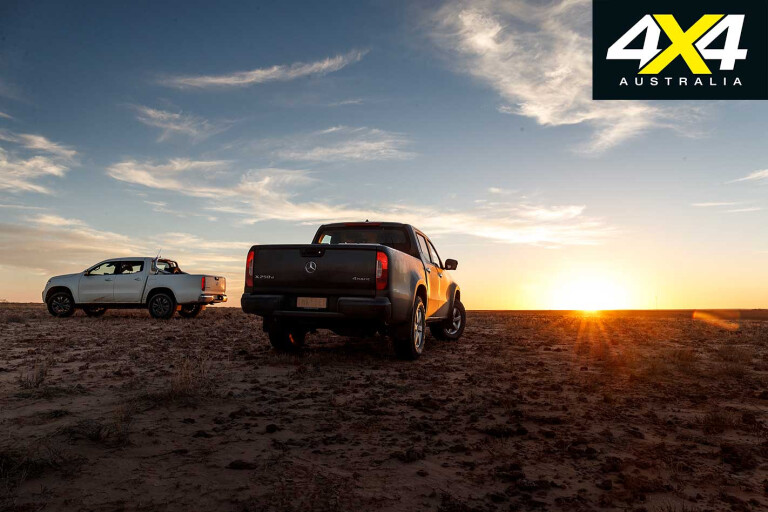



COMMENTS